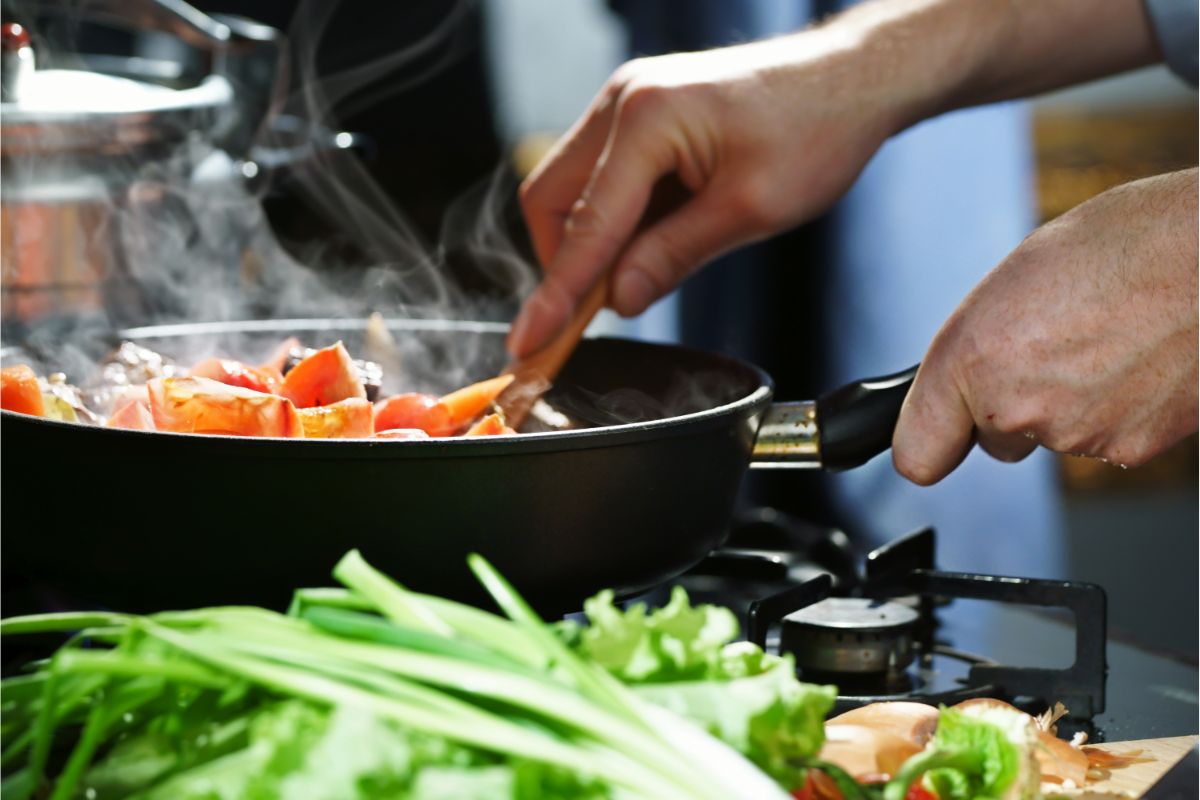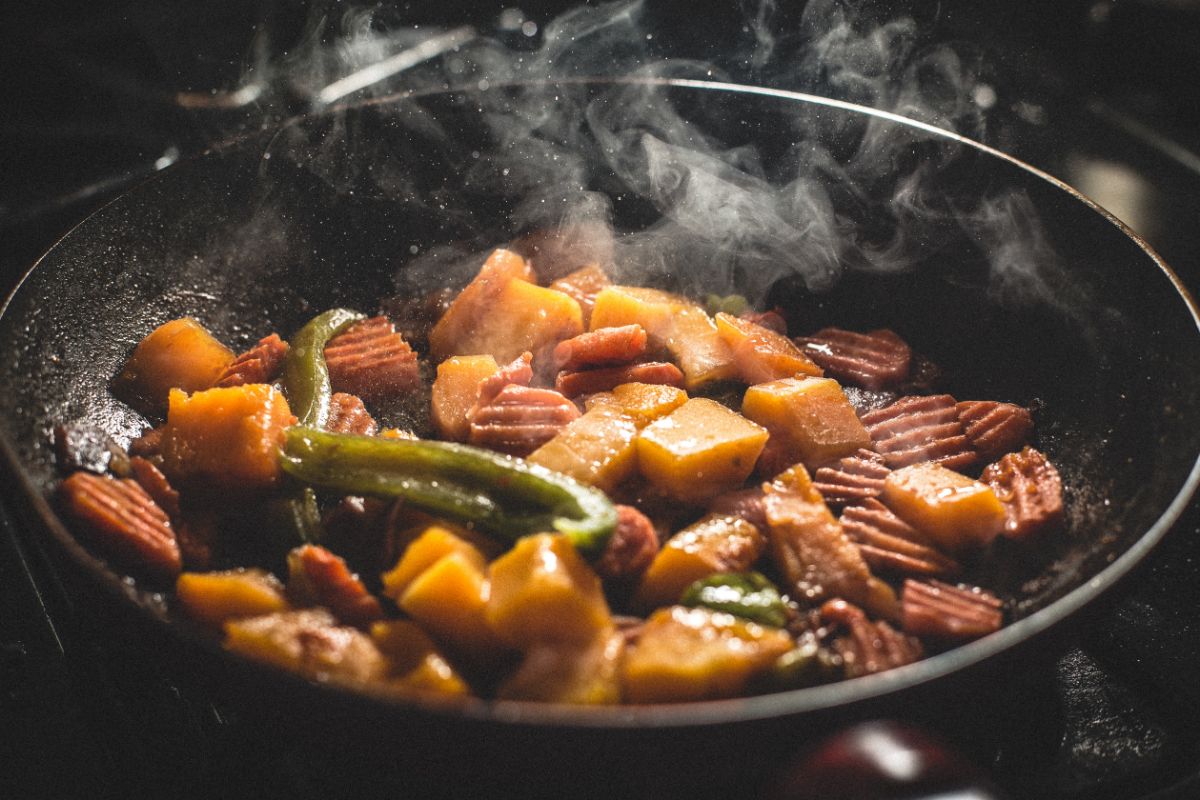Something that can be done to save time when cooking, to help your final result, is to change your cooking time if you are cooking at a different temperature. This will help you reach a more consistent result.

For example, if you are cooking the same item at 250 Fahrenheit or 350 Fahrenheit, you will end up with incredibly different results if you cook them for the same amount of time.
The one you cook at the lower temperature could end up noticeably undercooked which can be dangerous, or the one at the higher temperature could end up drying out or getting burned.
Because of this, we have put this guide together to give you all the information you need on how you can adjust your cooking times depending on what you are cooking.
Knowing how to do this properly will ensure that you end up with the most consistent results possible and you will generally become a better chef knowing how to do this.
So, if you have struggled with adjusting the cooking time for different items in the past, then keep reading to get the best results possible!
Using A Temperature Calculator
While it may seem like a pretty confusing task to try and balance all the different potential cooking times and temperatures, it is actually not that tricky when you know the rule you can apply to all of your cooking.
This formula is pretty simple, but make sure you understand it before putting it to use to ensure that you do not ruin your cooking projects.
You need to get the starting temperature and divide it by the end temperature, and this will give you the % change you are looking for. Then you can use this percentage change to adjust your cooking time.
Keep in mind that the starting temperature is the recommended temperature, and the ending temperature is the temperature that you are using for the cooking.
Then you multiply the recommended cooking time by the number you get from dividing the starting temperature by the ending temperature.
A simple example of this is if you have a recipe that asks you to cook something at 350 Fahrenheit, but you want to cook it at 450 instead. Then the starting temperature will be 350, and the new ending temperature will be 450.
So this is 350 divided by 450, the result of this is 0.77. So if the recipe says to cook it for 30 minutes, then you multiply this by 0.77 and this will give you 23 minutes, the new cooking time.
It might seem tricky when explained theoretically like this, however, when you put it into practice it is not that difficult.
You can also find some simple resources online like temperature converters which will do this for you automatically. However, if the temperature difference is small, then you can just change the cooking time by a little.
For example if you cook something at 375 instead of 350, then you only want to make the cooking time a little quicker, and if you are cooking something at 400 instead of 425, then you only need to make the cooking time a bit slower.
Once you think of it like this, then it becomes a lot less difficult.
However, if you want some simple numbers to make the conversions easier, we actually have some more examples if you want some more examples.
When it comes to mathematics like this, a lot of people understand better once they have some practical examples, so do not worry or give up if you do not understand the concept completely yet!
This whole section will work on the assumption that the recommended cooking time is an hour, or 60 minutes just to make the conversions easier to understand.
So, if you are asked to cook something at 400, but you want to cook it at 350, then 400 divided by 350 is 1.14, so if you multiply 60 minutes by 1.14 then you will get the new cooking time of 68.5 minutes.
Now if you are cooking something at 350 instead of the recommended 250, then this is a percentage change of 0.71, so if you multiply the 60 minutes by 0.71 then you will get 43 minutes. So you will cook your dish for 43 minutes at 350, instead of an hour at 250.
For a final example, if you want to cook at 350 instead of the recommended 450 Fahrenheit for an hour then this is a percentage change of 1.28, so you will want to multiply the 60 minutes by 1.28. This will give you a 77 minute cooking time at 350 instead of 60 minutes at 450.
Of course this does not just need to be applied to 60 minutes, and you can apply it to any amount of cooking time you want, so do not worry about it being too tricky.
The only difference you will need to make for a different cooking time is to switch out the 60 minutes for however many minutes it needs cooking, so for 2 hours, that would be 120, or 3 hours 180.
And if it needs half an hour, just switch out the 60 minutes for 30. You want to make sure that you are being careful when doing this with certain cooking projects as some items need to be cooked for a specific amount of time, so be careful with what you are using this on!
Can You Cook Something At A Lower Temperature For Longer?

So yes, if you are cooking something at a lower temperature, you will want to cook it for a longer time so you get the best results possible. So, cooking at a lower than recommended temperature, all this means is that you will need to use a longer cooking time.
To come up with the new time you want to use, all you need to do is use the formula from the previous section of the guide to get an exact number for how long to cook your food!
What About Baking?
When you increase your cooking time and lower the temperature, this will usually allow your food to cook more evenly, which in most cases is something a chef should desire, however, there are some cases, you do not want this.
To an extent, with baking projects, cooking lower and longer can give you a softer bake which has a better texture. In spite of this, there are some issues with this occasionally.
An example of this is that if you are baking something at a lower temperature, sometimes there is a chance that you will undercook your food.
With a lot of recipes, we would recommend that you would much rather overcook than undercook. This is because undercooking food can sometimes be unsafe to eat.
How To Convert Times To Different Temperatures
To convert the cooking time for your cooking to adjust for a different temperature, all you have to do is divide the original cooking temperature by the new temperature that you want to use.
Once you have this number, you want to multiply the cooking time by this difference to get the new cooking time you should use!
What To Keep In Mind When Adjusting Cooking Temperatures
When you are adjusting your cooking times when cooking, there are a few different factors that you should keep in mind to ensure that you get the best results when you are cooking.
If you keep these factors in mind when adjusting the times, you will avoid any simple mistakes that can ruin your cooking, issues like this can be more common when adjusting cooking times!
How Often Are You Opening The Oven?
Something that people often forget to consider when they are using their oven is that opening the oven can impact the temperature inside as well as the cooking time because of this.
It will actually take your oven anywhere from 5 to 15 minutes to fully reach the temperature it was before the door was opened after this.
Because of this, depending on how often or how long you are keeping the oven door open for, we recommend adding a few minutes every time you do this.
Quantity Of Food Being Cooked And Space
How you are spacing your food in your oven can have an impact on the cooking time and this is something that you want to consider when you are cooking in the oven.
For example, certain foods need to be cooked at different temperatures, and if your oven is full of food and different foods are touching, this change in surface area can impact the cooking time.
If you have two roasts cooking in your oven at the same time, depending on where they are placed in the oven and how big they are, they will likely cook at completely different times.
Also, if you have your food contained in one pot instead of spread out on a baking sheet, it will take longer to cook. Keep this in mind to get the best results when you are cooking, and remember how surface area impacts cooking.
Food’s Position In The Oven
You should keep in mind where the food is in the oven and how this will impact the overall cooking time. Generally speaking, food that is at the bottom of the oven will cook a lot slower than that which is closer to the top.
Also, the cooking time will depend on what type of heating your oven has. For example, certain ovens are much better at circulating the heat, so with these you do not need to worry about placement as much, while other ovens are much worse and the placement will have a greater impact on the final results.
Type Of Baking Pan Or Dish Used?
The material and shape of your baking pan or dish will impact your final results as well. For example, some materials like glass will take a lot longer to heat up than something like steel.
Also, like we mentioned earlier on, the spacing of your food will impact the cooking time. If the food has a wider surface area, it should be able to cook a lot faster and a lot more evenly than something that is more compact and thicker.
Summary
Hopefully this guide has given you all the information you need on how you can adjust the cooking times for your cooking when it comes to cooking with different temperatures.
Once you have the hang of these techniques, they should come to you pretty naturally, so you do not need to worry about getting it perfect.
In spite of this, when you are cooking something that needs to be cooked a certain way to be safe to eat, then we recommend that you are as careful as possible to ensure that you are not compromising your personal health!
- How To Reheat A Cheesesteak - November 5, 2023
- What Are Three Must Have Kitchen Knives? - September 22, 2023
- How To Protect Edges Of Pie Crust - June 15, 2023








